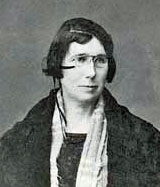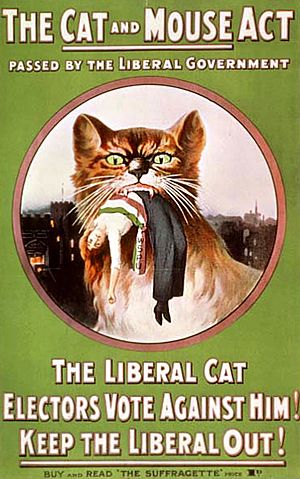Ethel Moorhead facts for kids
Quick facts for kids
Ethel Moorhead
|
|
|---|---|
 |
|
| Born |
Ethel Agnes Mary Moorhead
28 August 1869 Maidstone, Kent, England
|
| Died | 4 March 1955 (aged 85) Blackrock, Dublin, Ireland
|
| Nationality | British |
| Occupation | Painter, Suffragette |
| Known for | hunger strike and force feeding activism, and portraiture |
| Awards | Hunger Strike Medal for Valour |
Ethel Agnes Mary Moorhead (born August 28, 1869 – died March 4, 1955) was a brave British suffragette and talented painter. She was the first suffragette in Scotland to be fed by force during her protests.
Contents
Early Life and Family
Ethel Moorhead was born in Maidstone, Kent, England, on August 28, 1869. She was one of six children in her family. Her father, George Alexander Moorhead, was an army surgeon from Ireland. Her mother, Margaret Humphrys, was also Irish.
Ethel's family had a history of serving their country. Her grandfather fought in the Napoleonic Wars. Many of her relatives, including four of her brothers, became doctors. Her older sister, Alice Moorhead, was a pioneering female surgeon and physician.
Because her father was in the army, the family moved often. They lived in places like Shoeburyness, Mauritius, and Galway. Later, they settled in Edinburgh and then Dundee, Scotland. In Dundee, Ethel's family lived in a newly built house where she had her own art studio.
Becoming an Artist
Ethel Moorhead decided to become an artist when she was 29 years old. She studied painting in Paris, France, with famous artists like Alphonse Mucha and James Abbott McNeill Whistler.
After her training, Ethel returned to Dundee. She opened a portrait studio with her friend, Janet Oliphant. Ethel was a very skilled painter. Her first art exhibition in 1901 received great praise from local newspapers. They called her work "gems of the collection."
Ethel often painted her father, George. One of his portraits was called "a triumph of art" by a newspaper. She continued to exhibit her paintings, and their value increased over time.
Sadly, Ethel's sister Alice passed away in 1910, and her father died in 1911. After these losses, Ethel moved to Edinburgh. She continued to show her art in major exhibitions, including the Royal Scottish Academy.
Fighting for Women's Rights
Ethel Moorhead became a strong supporter of women's right to vote, known as a suffragette. She joined the Women's Social and Political Union (WSPU) in 1910. This group believed in taking strong actions to get women the vote.
Early Protests
Ethel gave her first speech for women's rights in March 1910. In December, she protested against Winston Churchill in Dundee. She threw an egg at him and used an umbrella to resist being removed from the meeting.
In 1911, Ethel became known as Dundee's first "tax-resister." This meant she refused to pay taxes because women couldn't vote. When officers came to take her belongings to sell, her supporters held signs saying "No Vote, No Tax."
Using Different Names
Ethel often used fake names like 'Mary Humphreys' or 'Edith Johnston' to avoid being caught. She broke windows in London as a protest. She once said, "I am a householder without a vote. I came from Scotland... to help my comrades."
She also attacked a display case at the Wallace Monument in Scotland. She left a note saying, "YOUR LIBERTIES WERE WON BY THE SWORD. RELEASE THE WOMEN WHO ARE FIGHTING FOR THEIR LIBERTIES." She believed women should fight for their freedom just as men had in the past.
Facing Prison
Ethel was arrested many times for her protests. When in prison, she often refused to follow the rules. She believed suffragettes should be treated as political prisoners, not criminals. She complained about the prison conditions and the way she was treated.
In 1912, Ethel was arrested for attacking a lecturer who had removed her from a meeting. She was fined, but the fine was paid, so she didn't go to prison for that action.
Later that year, she was arrested again with other suffragettes, including Emily Davison. They planned to protest at a meeting where David Lloyd George was speaking. Ethel broke a car window and was fined. She chose to go to prison instead of paying the fine. This was her first hunger strike. She was released early because someone anonymously paid her fine.
Ethel also had a reputation for damaging police cells and starting small fires as protests. She threw cayenne pepper at a police officer during a protest involving Prime Minister Herbert Asquith.
Force-Feeding and the "Cat and Mouse Act"
Ethel Moorhead became the first Scottish suffragette to be force-fed in prison. This meant that prison doctors would force food into her body when she went on hunger strike. She was force-fed more than 25 times. This made her very ill.
She was released from prison under the ""Cat and Mouse Act"". This law allowed hunger-striking suffragettes to be released when they became very sick. Once they recovered, they could be arrested again and sent back to prison. This was like a cat playing with a mouse.
Ethel's force-feeding caused a lot of public anger. Her treatment was even discussed in the British Parliament. Despite her illness, she continued her protests. She even escaped re-arrest by leaving her doctor's home in disguise.
In 1914, Ethel and her friend Frances Parker were arrested for trying to damage the Burns Cottage in Alloway. Ethel managed to escape, but Fanny was arrested. Ethel's experiences in prison and her strong protests showed her incredible bravery and determination.
Hunger Strike Medal
For her courage, Ethel Moorhead was awarded the Hunger Strike Medal "for Valour" by the WSPU. This special medal recognized her endurance and bravery in fighting for women's political rights.
Later Life and Legacy
During the First World War, Ethel Moorhead continued to help women. She worked with the Women's Freedom League to encourage women to find important war jobs.
In the 1920s, Ethel traveled in Europe. She even edited an arts magazine called This Quarter. This magazine published works by famous writers like James Joyce and Ernest Hemingway.
Ethel Moorhead passed away in Dublin, Ireland, in 1955.
Remembering Ethel Moorhead
Today, Ethel Moorhead is remembered for her important role in the fight for women's suffrage. A special plaque has been placed in Dundee, Scotland, near where her art studio used to be.
Her prison letters and records are kept at the National Archives of Scotland. They were part of an exhibition in 2018 that celebrated 100 years since some women in Britain gained the right to vote. This exhibition helped people learn about the brave suffragettes and their fight for equality.


